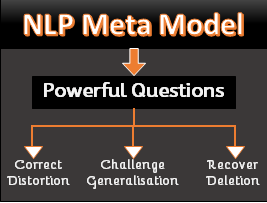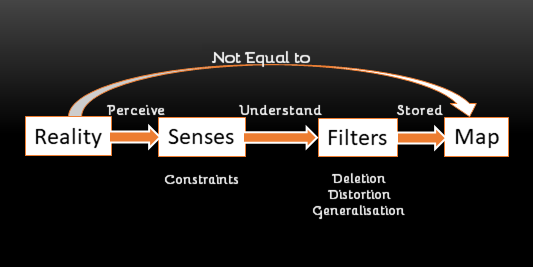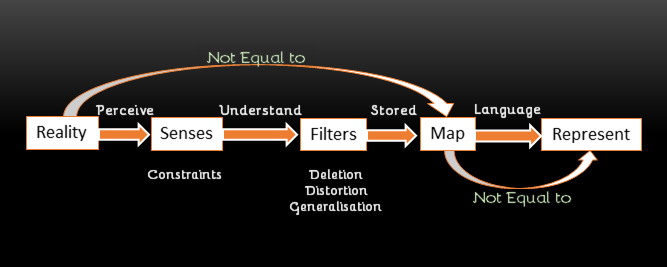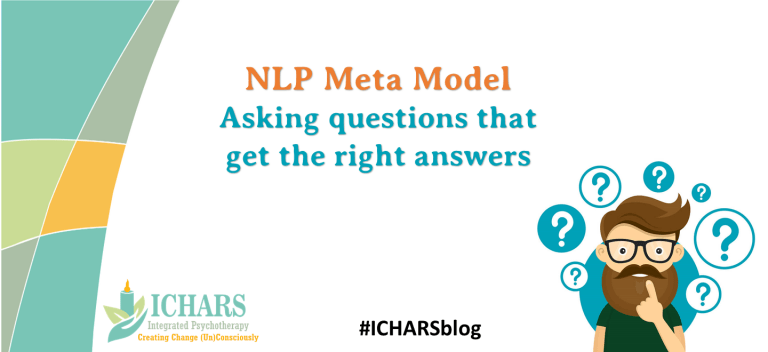
In the world of Neuro-Linguistic Programming (NLP), effective communication is key. The NLP Meta Model offers a powerful toolkit to enhance communication by clarifying language and uncovering hidden meanings.
What is the NLP Meta Model?
NLP Meta Model is a collection of a really useful set of questions that can be used to collect specific information by challenging the generalisations, correcting the distortions and recovering the deletions present in the speaker’s language.
In any conversation where specific information is invaluable, the NLP Meta Model can be priceless. It is a tool that can help you understand not just what a person is saying but also what exactly is happening in the person’s mind on the basis of which they are saying what they are saying.
Whether you are Coach, a therapist, a trainer, a leader, a manager, a parent, an HR professional, a marketing executive or a journalist, this is one tool that you should not only learn but also master.
Let me tell you what the meta model really does to answer that question.
What does NLP Meta Model do?
In an earlier post, we had discussed how the map is not equal to the territory. It is this understanding that is at the heart of the NLP meta model.
Let’s first summarise what we understand from “map is not equal to territory” and take it forward from there.

So we know that there is a reality which we perceive through our senses. Given that our senses have neurological constraints, we only perceive a part of reality instead of the complete reality. Since we have to be prepared for different eventualities based on the limited reality we have perceived, our system uses certain filters to make things easier for us.
These filters include:
- Generalisations
- Deletions
- Distortions
These filters lead to a greater degree of differences between objective reality and the perceived reality. The final information that we are left with after these filters are used becomes a part of our map or our subjective reality.
Now from the point of view of a therapy, when a client comes for therapy and says that he/she has a problem, where does the problem exist. In the map or the territory?
In most cases, the problem is in the map. Which means when the client describes their problem, they are trying to represent what is actually a part of their map and not necessarily the reality.
We already know from the foundation course that:
In short, it is very important for us to help bring their map closer to reality.
What is also very important to recognise is that there is not just a difference between the reality and map but also between the map and the client’s representation of the map.

Wait what does that mean?
A client represents his or her problem generally with the help of a language. It would be extremely rare if not impossible for a client to use language so specifically that he or she would represent the map exactly as it is.
Some amount of generalisation, deletion and distortion would take place due to the limitations of languages. Thus this creates a gap between the map that the client wants to represent also known as the deep structure and how the client represents it to others also known as surface structures.
Here is a detailed post discussing the deep structure and surface structure of language in detail.
That said, by now you would have rightly realised that in order to help the client effectively, one needs to bridge the gap between the representation of map, the map and the reality.
This is exactly what the meta-model does. The meta-model questions do this by helping the client not just identify these generalisations, deletions & distortions but also challenge the generalisations, correct the distortions and recover the deletions as far as possible.
In short, the NLP meta model questions focus on helping the clients
- Understand the problem through the collection of specific and relevant information
- Identify the steps and resources that can help in resolving these problems and
- Identifying the patterns of thinking and behaviours that have helped in the past
Understanding NLP Meta Model Violations
Generalizations, deletions and distortions can be further divided into Meta Model violations that encompass various linguistic patterns that obscure meaning or leave gaps in communication. Here are thirteen common violations:
- Simple Deletion: This occurs when essential information is omitted, leading to ambiguity.
For example, “I’m upset” lacks clarity about what specifically caused the upset.
Meta Model Question: “What specifically are you upset about?” - Comparative Deletion: When a comparison is made without specifying the elements being compared.
For instance, “This is better” lacks clarity about what it is being compared to.
Meta Model Question: “Better than what?” - Lack of Referential Index: Statements that lack specificity, leaving room for interpretation.
For example, “That’s interesting” without specifying what “that” refers to.
Meta Model Question: “What specifically is interesting?” - Unspecified Verb: When the action in a statement is not clearly defined.
For instance, “He hurt me” lacks clarity about how the person was hurt.
Meta Model Question: “How specifically did he hurt you?” - Nominalizations: Turning verbs into nouns, which obscures the action or process.
For example, “His rejection is painful” masks the specific actions leading to the perceived rejection.
Meta Model Question: “How specifically is his rejection painful?” - Universal Quantifiers: Statements using words like “always” or “never,” which oversimplify reality and ignore exceptions.
For instance, “You never listen to me.”
Meta Model Question: “Never? Are there any exceptions?” - Model Operator of Necessity: Statements implying a necessity without evidence.
For example, “I must do this” without specifying why it is necessary.
Meta Model Question: “Why must you do this?” - Model Operator of Possibility: Statements suggesting impossibility without evidence.
For instance, “I can’t do it” without specifying the barriers.
Meta Model Question: “What specifically prevents you from doing it?” - Presuppositions: Assumptions made within statements.
For example, “When are you going to apologize?” presupposes that an apology is necessary.
Meta Model Question: “What makes you think I need to apologize?” - Cause and Effect: Assuming a causal relationship without evidence.
For instance, “You made me angry.”
Meta Model Question: “How specifically did my actions cause you to feel angry?” - Mind Reading: Assuming knowledge of someone else’s thoughts or feelings.
For example, “I know you’re lying.”
Meta Model Question: “How do you know I’m lying?” - Lost Performative: When the performer of an action is not specified.
For example, “It’s known that…”
Meta Model Question: “Known by whom?” - Complex Equivalence: Assuming two unrelated events are equivalent.
For example, “If she loved me, she would call.”
Meta Model Question: “How does her calling equate to her love for you?”
Why Coaches and Psychologists should learn this model?
Coaches and psychologists play pivotal roles in facilitating personal growth and transformation. By incorporating Meta Model techniques into their practice, they can:
- Enhance Client Understanding: Meta Model questions help clarify clients’ language, uncovering deeper meanings and underlying beliefs.
- Challenge Limiting Beliefs: By addressing Meta Model violations, coaches and psychologists can challenge clients’ limiting beliefs and encourage reframing for personal empowerment.
- Improve Communication: Clear communication is essential in therapeutic relationships. Meta Model techniques foster clearer dialogue, fostering trust and rapport.
- Facilitate Behaviour Change: By addressing linguistic patterns, coaches and psychologists can help clients identify and modify behaviour patterns more effectively.
Applying NLP Meta Model Questions: A Step-by-Step Process

- Listen Actively: Pay close attention to the client’s language patterns, noting any deviations or inconsistencies.
- Identify Violations: Recognize instances of generalizations, deletions, and distortions in the client’s communication.
- Select Appropriate Questions: Choose Meta Model questions that address the specific violation present in the client’s language.
- Ask Open-Ended Questions: Use open-ended questions to encourage reflection and deeper exploration of the client’s thoughts and feelings.
- Encourage Self-Reflection: Guide the client in examining their language patterns and the underlying beliefs or assumptions they reveal.
- Facilitate Reframing: Help the client reframe their language and perspective, fostering a more empowering and constructive mindset.
By integrating Meta Model techniques into their practice, coaches and psychologists can unlock deeper insights, foster personal growth, and empower clients to create positive change in their lives. Effective communication is not just about what we say but how we say it, and mastering Meta Model techniques is the key to unlocking clearer, more meaningful dialogue.
Case Study: Applying the NLP Meta Model in Coaching and Therapy
Client Background: Sarah, a mid-level manager in a tech company, sought coaching to overcome feelings of overwhelm and imposter syndrome as she transitioned into a new leadership role. She often felt anxious about making decisions and doubted her abilities to lead effectively.
Coaching Process: The coach began by establishing rapport and trust with Sarah, creating a safe space for open dialogue. Through active listening, the coach noticed patterns of self-doubt and negative self-talk in Sarah’s language. Recognizing the opportunity to apply the Meta Model, the coach introduced Sarah to the concept of linguistic patterns and the importance of clear communication in coaching.
Application of the NLP Meta Model:
- Identifying Deletions: During coaching sessions, Sarah often made vague statements, such as “I can’t handle this” or “It’s too much.” The coach used Meta Model questions to challenge these deletions and encourage Sarah to provide specific details about her challenges:
- Coach: “When you say ‘It’s too much,’ what specifically feels overwhelming to you?”
- Sarah: “I guess it’s the pressure to meet deadlines and manage my team effectively.”
- Challenging Generalizations: Sarah frequently used universal quantifiers like “I always mess up” or “Everyone is better than me.” The coach recognized these as generalizations and prompted Sarah to consider exceptions and alternative perspectives:
- Coach: “Is it really true that you always mess up, or are there times when you’ve succeeded?”
- Sarah: “Well, I did handle that project well last month.”
- Addressing Distortions: Sarah often engaged in mind reading, assuming she knew what others thought of her. The coach used Meta Model questions to challenge these distortions and encourage Sarah to seek clarification:
- Coach: “How do you know your team thinks you’re not capable? Have you discussed your concerns with them?”
- Sarah: “No, I haven’t. I guess I assumed based on their reactions.”
Results: Through consistent application of the Meta Model, Sarah gained greater clarity about her challenges, recognized her cognitive distortions, and developed more constructive ways of thinking and communicating. She learned to challenge her limiting beliefs, set realistic goals, and communicate assertively with her team. Over time, Sarah’s confidence grew, and she successfully navigated her leadership role with greater ease and effectiveness.
Key Takeaways: This case study illustrates how the Meta Model can be applied in coaching to challenge limiting beliefs, clarify communication, and facilitate personal growth. By identifying and addressing deletions, generalizations, and distortions, coaches help clients like Sarah gain insight, confidence, and resilience in navigating their professional challenges.
Learning NLP Meta Model Questions
Meta Model as a topic is covered extensively in the level 2 of our Advanced Coaching Certification Program and the Advanced Psychotherapy Certification Program.
In case you are not planning to join the certification program for now, you can enroll for the online module on effective questioning skills and develop a deeper understanding about the NLP Meta Model questions.

